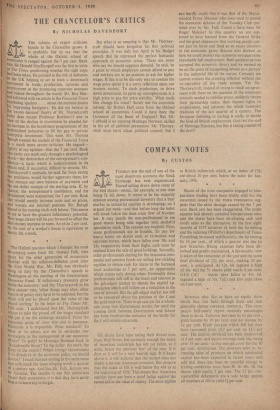COMPANY NOTES
By CUSTOS TUESDAY saw the end of one of the most disastrous accounts the Stock
46.% Exchange has ever experienced. Forced selling drove down some of the best shares—slim, for example, at one time being 7s. 6d. down. It seems to be the majority opinion among professional investors that a bear market in industrial equities is developing—as I .argued last week—:and that before long the index will break below the Suez crisis 'low' of Novem- ber. It may puzzle the non-professional to see good shares being sold together with doubtful speculative stock. The reasons are twofold. First, some professionals are in trouble. To pay for heavy losses on shares such as ULTRAMAR and MILFORD Docks, which have fallen over 30s. and 33s. respectively from their highs, cash must be realised from the sale of good holdings. Secondly, other professionals dealing for the insurance com- panies and pension funds are selling low-yielding equities to obtain cash for loans to the harassed local authorities at 7 per cent., an opportunity which comes only during crises. Eventually these professionals will call in the loans and reinvest in the gilt-edged market to obtain the capital ap- preciation which will follow on a reduction in the rate of interest. But the gilt-edged market has still to be reassured about the position of the £ and the gold reserves. There is no case yet for a whole- sale jump into Government stocks, for until the coming clash between Government and labour has been resolved the outcome of the battle for the will remain uncertain.
Oil shares have been taking their dismal tune from Wall Street, but curiously enough the index of American industrials has not yet fallen, as I write, below the previous `low' of the year. If it does so it will be a very bearish sign. It it keeps above it, it will indicate that the market does not expect a serious American recession. But observe that the index at 456 is well below the 488 as at the beginning of 1956. This means that American equities have not been a good hedge against the recent fall in the value of money. The same applies
to British industrials which, at an index of 178, are about 10 per cent, below the index for Jan- uary, 1956.
Shares of the store companies engaged in hire- purchase trading have been widely sold but the statement issued by the TIMES FURNISHING sug- gests that the extra damage caused by the 7 per cent. Bank rate has been exaggerated. The credit squeeze had already curtailed hire-purchase sales and the stores have been developing cash and credit sales as the alternative. In the first eight months of 1957 turnover of both the furnishing and the tailoring (Willerby) departments of Times Furnishing increased satisfactorily, the furnishing by 16 per cent., of which a quarter was due to new branches. Rising expenses ha've been ab- sorbed and profits maintained. A favourable view is taken of the remainder of the year and the same final dividend of 121 per cent., making 20 per cent., is anticipated. At 12s. 6d. (against a high of 16s. 6d.) the 5s. shares yield nearly 8 per cent.
GUS ('A') - shares have fallen to 41s. 6d. (against a high of 55s. 71d.) and also yield clbse on 8 per cent.
Investors who like to have an equity share which they• can hold through thick and thin generally choose IMPERIAL CHEMICAL. This com- pany's half-yearly report certainly encourages them to do so. Turnover has risen by 61 per cent., gross income by 10 per cent. and net income by 16 per cent. Profit margins which fell last year have recovered from 10.7 per cent. to 13.1 per cent. The interim dividend has been maintained at 4 per cent. and equity earnings look like being over 35 per cent.—a fine enough cover for the 10 per cent. distribution. The directors refer. to 'in- creasing sales of products on which substantial capital has been expended in recent years' and add that there has been rio matertal change in trading conditions since June 30. At 40s. 3d. the shares yield nearly 5 per cent. The 51 'per cent. convertible debentures are a safe hedge against all weathers at 104 to yield 54- per cent.






















































 Previous page
Previous page